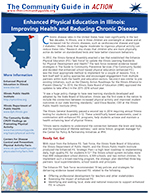Enhanced Physical Education in Illinois: Improving Health and Reducing Chronic Disease
Summary
 In Illinois, one in three children are overweight or obese and at increased risk for chronic diseases, such as cardiovascular disease and type 2 diabetes. Concerns of rising obesity rates led policymakers in Illinois to develop and implement an enhanced physical education program in schools based on evidence-based intervention strategies from The Community Guide. (Released 2016)
In Illinois, one in three children are overweight or obese and at increased risk for chronic diseases, such as cardiovascular disease and type 2 diabetes. Concerns of rising obesity rates led policymakers in Illinois to develop and implement an enhanced physical education program in schools based on evidence-based intervention strategies from The Community Guide. (Released 2016)
Read the previous Community Guide in Action story, Reducing Obesity Rates in Illinois: Path to Enhanced Physical Education [PDF – 409 kB], to learn more about the state’s efforts to improve students’ health.
Lessons Learned
- Evidence-based interventions can appeal to many audiences. Enhanced school-based P.E. appeals to health professionals, educators, and parents because of the benefits associated with students’ health and academic performance.
- Stakeholders are key participants in decision-making. Multiple organizations collaborated to produce the strategic plan and develop procedures for annual fitness testing and data reporting.
Story
In 2012, the Illinois General Assembly enacted a law to establish the Enhance Physical Education (P.E.) Task Force.3 The Task Force was charged with updating the Illinois Learning Standards for Physical Development and Health to reflect best practices and recommended strategies to promote health, wellness, and fitness in schools. In 2013, the Illinois State Board of Education (ISBE) approved the updates to take effect in the 2015-2016 school year.
“It was a huge policy change to have new learning standards developed and adopted by the State Board of Education. Illinois was the first state in the nation to include the connection between increased physical activity and improved student outcomes in our state learning standards,” said Elissa Bassler, CEO at the Illinois Public Health Institute (IPHI)
The Illinois General Assembly passed a second law in 2014 requiring annual fitness testing for students in grades 3-12. These scientifically based assessments, used in combination with enhanced P.E. programs, help students achieve and maintain a health-enhancing level of physical fitness.
“Illinois wants students to understand the connection between the brain and body, and the importance of lifetime wellness,” said Janna Simon, program manager for the Center for Policy & Partnership Initiatives at IPHI.
Ready. Set. Go!
With input from the Enhance P.E. Task Force, the Illinois State Board of Education, the Illinois Department of Public Health, and the Illinois Public Health Institute produced the Enhanced P.E. Strategic Plan a high-level roadmap to implementing daily, high-quality P.E. for students K-12.4 The Illinois school system includes more than 800 independent school districts, 4,500 schools, and two million children. To implement such a broad-reaching program, the strategic plan identified three key partners: local superintendents, school boards and principals.
The Enhance P.E. Task Force recommended 19 key policies and strategies for delivering evidence-based enhanced P.E. related to the following:
- Offering professional development for teachers and other stakeholders
- Assessing the impact of enhanced P.E.
- Identifying and seeking local, state and national resources to support enhanced P.E. in schools
To promote their work, the Enhance P.E. Task Force carefully prepared messages geared to different segments of the school community and public. Local communities were receptive to their strategies and policies; many people became loyal supporters of enhanced P.E. and a variety of organizations teamed to promote this project.
To prepare for implementation, IPHI offered teacher trainings, called Pump Up P.E.: Promote Health, Learning and Lifelong Fitness. The training offered practical, immediately applicable strategies, tools, and resources to increase physical activity levels in classes. After trainings, teachers reported increased awareness of resources and strategies to support physical activity and knowledge of ways to add more physical activity to P.E. classes. Participants also reported gaining knowledge about the impact of physical activity on brain function.
What is Enhanced P.E.?
During enhanced P.E. classes, students spend at least half of their time participating in moderate-to-vigorous physical activity. The Community Preventive Services Task Force recommends enhanced P.E. to increase physical activity levels among children and adolescents. Research shows that children who are more physically active and fit have improved cognitive function, perform better in class and on standardized tests, and have better classroom behaviors.5. These outcomes are important to school and district administrators as they strive to meet rigorous standards for students’ academic achievement.
Tracking Progress
Starting in the fall of 2016, students in grades 3-12 will participate in annual fitness testing. Students will track their progress, set goals for improvement, and learn more about health and wellness. “Fitness testing helps teachers understand their students’ strengths and weaknesses and helps the students become more fit over time,” Bassler said. Researches and local and state officials will have access to aggregate data and be able to track changes over time.
1Kaiser Family Foundation. State health facts. Accessed 9/14/16. Available at URL: http://kff.org/statedata/
2Illinois Enhance PE Task Force. Enhancing physical education in Illinois: how investing in P.E. yields higher achievers. 2012. Accessed 9/14/16. Available from: http://iphionline.org/pdf/IPHI_Enhanced_PE_Fact_Sheet.pdf.
3Public Act 097-1102, Illinois General Assembly (2012). Available at URL: http://www.ilga.gov/legislation/publicacts/fulltext.asp?Name=097-1102
4Illinois Public Health Institute, Illinois State Board of Education, Illinois Department of Public Health. Illinois Enhanced Physical Education Strategic Plan. Authors; 2012. Available at URL: http://www.idph.state.il.us/pdf/EnhancedPE_StrategicPlan_Final2.pdf
5Centers for Disease Control and Prevention, National Center for Chronic Disease Prevention and Health Promotion, Division of Population Health. Health and academic achievement. Accessed 9/14/16. Available at URL: http://www.cdc.gov/healthyyouth/health_and_academics/pdf/health-academic-achievement.pdf
More Information
Illinois Public Health Institute
Illinois Department of Public Health
Community Preventive Services Task Force findings referred to in this story:
The Community Guide: Task Force Findings on Physical Activity